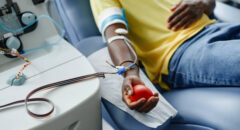
Singer, wife and soon-to-be mother Jordin Sparks' step-sister Bryanna Jackson-Frias, 16, died Tuesday evening of complications from her lifelong battle with sickle cell anemia. Sickle cell anemia causes red blood cells to stick to vessel walls, blocking blood flow and preventing oxygen from reaching tissues; the lack of oxygen can damage organs and cause pain so severe it requires hospitalization.
“Bry went peacefully to Heaven,” Sparks’s mom, Jodi Jackson, wrote on Facebook Wednesday alongside a photo of her late step-daughter. “I can’t help to think [that] she’s smiling just like this. Thank you all for your prayers.”
Sparks, 28, first revealed Bryanna was suffering a sickle cell episode on Tuesday.

Sickle cell disease is more common in certain ethnic groups, including:
- People of African descent, including African-Americans (among whom 1 in 12 carries a sickle cell gene)
- Hispanic-Americans from Central and South America
- People of Middle Eastern, Asian, Indian, and Mediterranean descent
But why is sickle cell so deadly?
Normally, your red blood cells are flexible and round, moving easily through your blood vessels. In sickle cell anemia, the red blood cells become rigid and sticky and are shaped like sickles or crescent moons. These irregularly shaped cells can get stuck in small blood vessels, which can slow or block blood flow and oxygen to parts of the body.
Because of this blocked blood flow, sickle cell anemia can lead to:
Stroke. A stroke can occur if sickle cells block blood flow to an area of your brain. Signs of stroke include seizures, weakness or numbness of your arms and legs, sudden speech difficulties, and loss of consciousness. If your baby or child has any of these signs and symptoms, seek medical treatment immediately. A stroke can be fatal.
Pulmonary hypertension. People with sickle cell anemia can develop high blood pressure in their lungs (pulmonary hypertension). This complication usually affects adults rather than children. Shortness of breath and fatigue are common symptoms of this condition, which can be fatal.
Organ damage. Sickle cells that block blood flow through blood vessels immediately deprive the affected organ of blood and oxygen. In sickle cell anemia, blood is also chronically low on oxygen. Chronic deprivation of oxygen-rich blood can damage nerves and organs in your body, including your kidneys, liver and spleen. Organ damage can be fatal.
Blindness. Sickle cells can block tiny blood vessels that supply your eyes. Over time, this can damage the portion of the eye that processes visual images (retina) and lead to blindness.
Priapism. Men with sickle cell anemia can have painful, long-lasting erections, a condition called priapism. As occurs in other parts of the body, sickle cells can block the blood vessels in the penis. This can damage the penis and lead to impotence.
Because sickle cell disease symptoms can begin by four months of age, early diagnosis is critical. All newborns in the United States are now...
...tested for the disease. Sickle cell disease can be identified before birth by testing a sample of amniotic fluid or tissue from the placenta. People who carry the sickle cell gene can seek genetic counseling before pregnancy to discuss options.
Signs and symptoms of sickle cell disease can be mild or severe enough to require frequent hospitalizations. They may include:
- Anemia (looking pale)
- Dark urine
- Yellow eyes
- Painful swelling of hands and feet
- Frequent pain episodes
- Stunted growth
- Stroke
Jordin's family asks that in lieu of gifts, donations be sent to El Paso Children’s Hospital.
Jordin ended her message with, "Tomorrow is not promised to any of us. Don't ever skip a chance to tell someone you appreciate them or how much you love them. Please, please continue to cover their families and our family with thoughts and prayers." #unicornsdontdie #sicklecellsux









